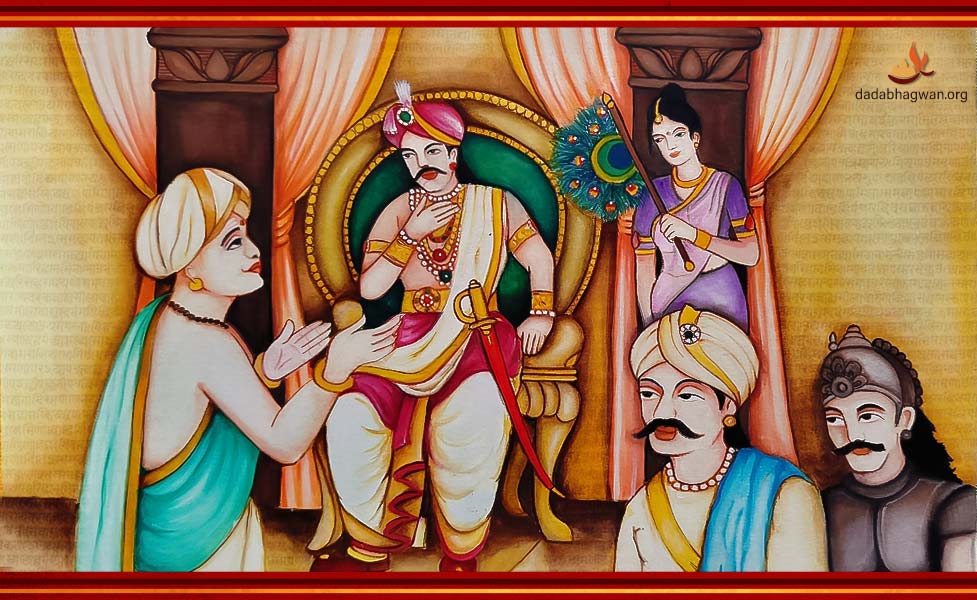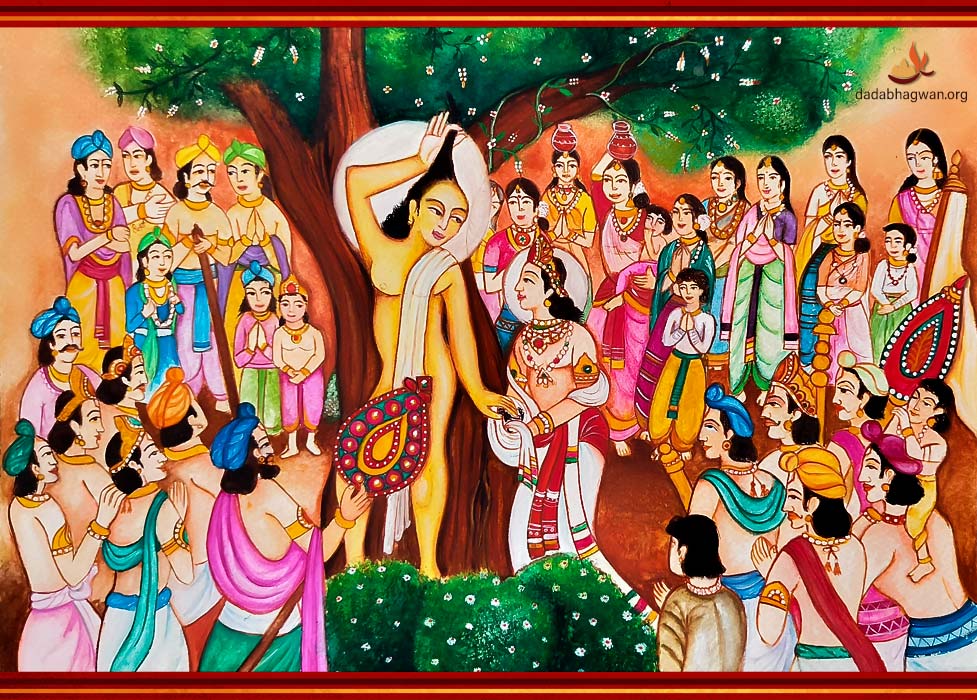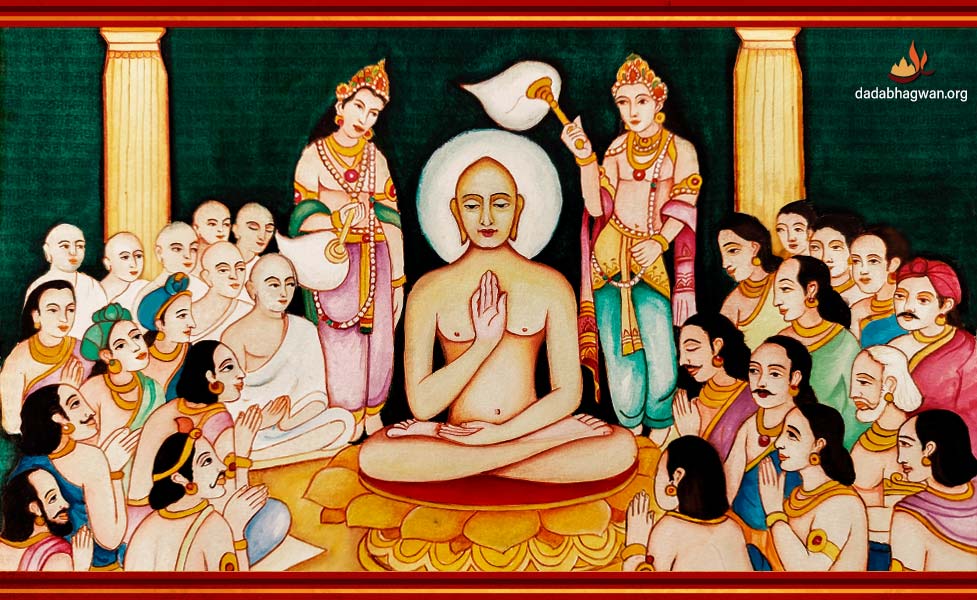SHREE SAMBHAVNATH BHAGWAN: LIFE STORIES OF THE THIRD TIRTHANKARA
Shree Sambhavnath Bhagwan was the third Tirthankara of the present time cycle. His body was golden in complexion and His height measured 400 bows.
Sambhavnath Bhagwan’s symbol (laanchan) is horse. Trimukh Yaksh Dev and Duritaari Yakshini Devi are the Lord’s Shaasan Dev and Shaashan Devi, respectively. Come, let’s now read about the Lord’s two births before being a Tirthankara and His life story as a Tirthankara.
Shree Sambhavnath Bhagwan – The Past Births
Tirthankara Shree Sambhavnath Bhagwan’s antepenultimate birth was as King Vipulvahan in the city of Ksehmpuri, located in the Airavat Kshetra of the Ghatki Khand Dweep.
King Vipulvahan was a very honest and people-loving person. He ruled in a manner that not even slightest hurt be caused to the people living in his kingdom. He was extremely proficient in politics. He used to award people for the good work done by them in the kingdom and punish those who did wrong. He didn’t have any ego of his power; he was very humble.

King Vipulvahan held deep interest in religion. He used to spend his surplus time in mediation, religious study and worship of Tirthankaras. He used to follow the 12 vrats of Shravak dharma; not a single person would return hungry or empty handed from his kingdom. King Vipulvahan was very famous for his generous deeds.
Once it so happened that in the kingdom of King Vipulvahan, there was a devastating drought and people were deprived of food and water. Even for animals, due to lack of fodder, a situation of crisis had got created. Because of scarcity of food, people had begun to eat the leaves and roots of the trees. People would wander a lot just to get even one bite of food. The family members were fighting with each other for food. The subjects had started stealing as they did not have any employment. People had stopped practicing religion.
When King Vipulvahan came to know about this situation and the people’s behaviour, he thought that it was his responsibility to protect his subjects. He called his court members and announced that all of his money, food and water be allowed for the consumption of the Chaturvidh Sangh, i.e., the Sadhus, the Sadhvis, the Shravaks and the Shravikas. He ordered his cook that whatever food is cooked in the palace should first be given to Sadhu-Sadhvis, Shravaks-Shravikas. Thereafter if anything is left, only then he would consume it. If nothing is left, then that day, he would fast. As long as famine continued, King Vipulvahan donated food to his people and with a true heart, he served people selflessly.
Since the time of drought, remaining hungry himself, he donated food to people and served the saints in the best manner. As a result, King Vipulvahan bound the Tirthankara-naam-gotra karma. Many people donate food or make other kind of donation; however, that does not get one the Tirthankara gotra. However, as donation was made without an iota of ego and with great compassion within, the Tirthankara gotra was bound by King Vipulvahan.
After the drought, normalcy returned. One day, while King Vipulvahan was sitting in the palace’s terrace, far away, he saw a small cloud. Seeing it, he was happy thinking that it would rain. However, just then with a sudden gust of wind, that small cloud passed ahead and scattered away. While observing all this, it flashed inside King Vipulvahan that this world, our body, everything is temporary. Thus, with a feeling of intense dispassion towards the world, King Vipulvahan’s moha got dissolved and he got free from all worldly bondages.

A balance sheet of our entire life’s karmas is derived at the time of our death. Based on our inner state at the time of death, our next life form gets determined accordingly. If we die with worries in our head, then the birth takes place in animal life form. If at the time of death, religious meditation prevails, then we get birth in a good life form. Therefore, King Vipulvahan thought, “If I do not take renunciation right now, then after death, what kind of life form would I get?” Hence, all worldly luxuries appeared temporary to King Vipulvahan and he realized that it is worth getting the work for Moksha done by remaining in the Real form of the Self. King Vipulvahan handed over to his son all his royal responsibilities and took Diksha from a very renowned Aacharya of his time, Shri Swayamprabha Suri.
After Diksha, King Vipulvahan became pure by practicing a lot of meditation, worship, self-restraint, riddance of kashays and repentance-pratikraman for all the faults committed in his entire life. After taking Diksha, he attained Vees Sthanaks and bound the Tirthankara-naam-gotra karma.
The next birth of Sambhavnath Bhagwan happened in the ninth celestial world named Aanat, and there, he enjoyed heavenly happiness for a long time.
Shree Sambhavnath Bhagwan – Childhood, Diksha and Keval Gnan
From the celestial life form, Sambhavnath Bhagwan was conceived and then was born to King Jitaari and Queen Sena Devi on the fourteenth day of the bright half of the Hindu month of Maagsar in the Shraavasti Nagri, located in the Bharat Kshetra.
When Lord Sambhavnath was in the womb of Queen Sena Devi, that year, in the kingdom, the crop of Sambha, meaning groundnut, was harvested profusely. From this, came the Lord’s name as Sambhavnath. From birth, the Lord was having three types of Gnan namely, Shrut, Mati and Avadhi. Prince Sambhavnath grew up amidst royal comforts but He had no interest at all in the luxurious lifestyle. Following the unfolding of karma and the commandment (aagna) of His parents, Prince Sambhavnath was married and crowned at the appropriate age.
After a very long and peaceful rule, upon the request of the celestial gods, Lord Sambhavnath took Diksha. After taking Diksha, Lord made massive donations for a year (varsidaan) and later, His Diksha ceremony was celebrated.
The celestial gods took all care of Tirthankara Bhagwan’s Diksha celebrations. Along with King Sambhavnath, 20,000 other kings also took Diksha. After 14 years of Diksha, King Sambhavnath finished His sanjvalan karmas and attained Omniscience, Keval Gnan, on the fifth day of the dark half of the month of Kartik.
Only after attaining Omniscience, the Tirthankaras give Deshna; until then, they are silent. After the Tirthankara Bhagwan attains Omniscience, the celestial beings create the Samovasaran, the divine assembly. After Tirthankara Bhagwan attains Omniscience, the Ganadhars (chief disciples of a Tirthankara) get established and they all get seated in the Lord’s Samovasaran.
Lord Sambhavnath’s chief Ganadhar was Chaaru. He grasped full knowledge from Sambhavnath Bhagwan and then gave sermons to people; he was sowing the seeds of Moksha in people’s life. Many people, just with the darshan of the Lord, attained Omniscience and got free from all sufferings.

Deshna – Anitya Bhavna
The effect of the speech of a Tirthankara Bhagwan is such that it can pierce through all veils and help the other person attain Omniscience. His speech is completely free of all veils of ignorance. Lord’s Tirthankara-naam-gotra karma has been bound so that people attain Moksha. Because along with own Self, a Tirthankara helps many others attain Moksha too. Hence, the celestial gods also create Samovasaran with an intent that how can maximum people avail the Tirthankara Bhagwan’s speech. The celestial beings send a message to every house, inviting them to come to the Tirthankara Bhagwan’s Deshna and Samovasaran.
Lord Sambhavnath, in His Deshna, threw light on the important aspects of ‘Anitya Bhavna’. In the Deshna, Lord explained which things in this world are ‘Nitya’ and which things are ‘Anitya’.
Anitya means temporary and Nitya means permanent. While studying scriptures or when in Satsang, only for a few moments we feel that this entire world is temporary and the Soul alone is permanent; that has no meaning at all. To have a lasting understanding of this, it is necessary to understand that which thing is permanent and which thing is temporary. Whatever we are experiencing in this world with our five senses, we need to check whether that is temporary or permanent! Let’s see how we can check it!
- The people around us such as our parents, spouse, children—are they all permanent? No! If they would be permanent relations, then they would take birth and would die together. All these relations are temporary.
- All our wealth such as house, bungalow, car, scooter, money—are all these permanent? No! The wealth shall remain here only and we will go away; such is this world!
- The delicious food we eat with different tastes—it may take a long time to prepare all these delicacies but it gets eaten in no time. Further, does that taste remain forever? Well, really it remains for a few seconds only on the tongue! Therefore, this awareness of Anitya should remain all the time. While eating, the awareness should remain that this taste is permanent or temporary!
- The sweet sleep that we enjoy is temporary.
- The body that we believe to be ours, its health, its cleanliness, its organs, and its diseases are all temporary.
- Even our name is temporary; it is just a label given to identify the body. In reality, our real form is the pure Soul.
- The words that we speak are temporary.
- The thoughts that arise to us are temporary; they arise and pass away.
- The intellect, the worldly consciousness and the ego are all temporary.
- Even the different types of fears we experience are temporary. While passing by the cremation ground, we fear the ghost and if we attend some happy occasion, then we forget that fear. Hence, all these fears are temporary.
- Respect-insult, anger-pride-deceit-greed, attachment-hatred, jealousy-envy—all of these keep coming and going; therefore, everything is temporary.
In this world, everything is temporary, except our own true Self, which is permanent. Thus, the Lord gave a beautiful explanation on Anitya bhavna in His Deshna.
In His Deshna, the Lord also explained the principle of Tripadi, comprising of utpaad (formation, arising), vyay (destruction, passing away) and dhruv (permanence, being stable). A natural element means it has dravya (substance of an element composed of all guna), guna (intrinsic functional properties), and paryay (phases). There are six eternal elements in this Universe namely, Chetan meaning the Soul, jada meaning inanimate matter, aakash meaning space, kaal meaning time, gatisahayak meaning motion, and sthitisahayak meaning inertia. Utpaad, vyay and dhruv are the properties of each of these elements. Every element has its own dravya and gunadharma, both of which are permanent. No change can happen therein; but the phases always arise, remain still for a period of time, and then pass away. In the Deshna, Lord explained this subtle elemental knowledge to people; through this elemental knowledge, people gained a precise experience of what and how is the element of Soul. For a long period, the Lord gave Deshna to people.
Nirvana
In the family of Sambhavnath Bhagwan, there were 2,00,000 Sadhus, 3,36,000 Sadhvis, 15,000 Keval Gnanis, 2,93,000 Shravaks and 6,36,000 Shravikas. Finally, Sambhavnath Bhagwan’s Nirvana took place along with 1,000 Sadhus from the Samet Shikharji Mountain. Samet Shikharji is an extremely pure pilgrimage site from where 20 Tirthankaras of this time cycle attained liberation.
At the time of Bhagwan’s Nirvana, Shaileshikaran kriya took place in which the Soul shrunk from the entire body, and from the Brahmarandhra which is an aperture at the crown of the head, proceeded towards Siddha Kshetra. All the celestial gods performed the final rites of Nirvana and collected His remains and belongings. This is done by the celestial gods as each thing of a Tirthankara is considered auspicious and worthy of worship.
On reading Sambhavnath Bhagwan’s life story, by intending and worshipping like Him, even we can become a traveller on the path of Moksha.
subscribe your email for our latest news and events





